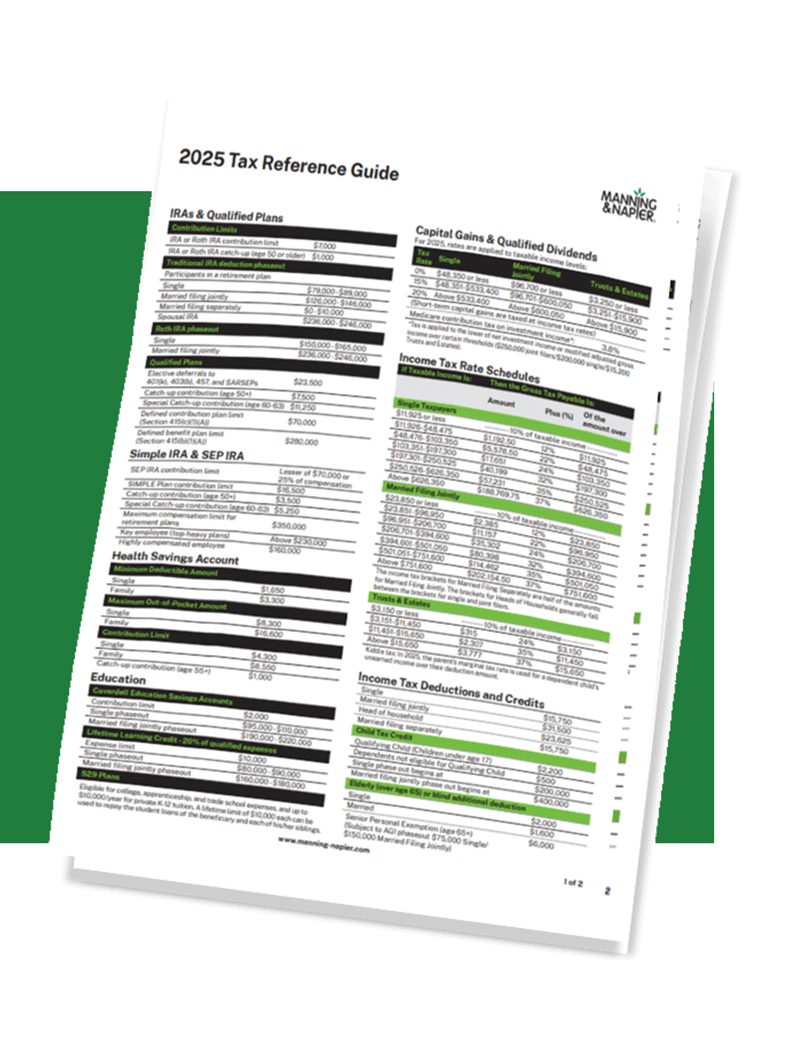Taxes are a fact of life, and sound tax management can be a critical component of a successful investment strategy. By applying an intentional tax plan within an investment strategy, investors can optimize portfolio performance, potentially helping to increase their after-tax returns over a lifetime.
Before we dive into the ins and outs of tax management, it’s only right to note that focusing too much on taxes within a portfolio can have negative consequences. The goal of effective tax management is to align what you already plan to do with an optimized framework. Remember to work closely with your advisor and approach the process with the goal of striking a balance between reducing taxes, maximizing wealth, and achieving your goals.
Why Tax Management Matters
There are two paths in which taxes can impact investment returns. You either pay more taxes and see lower returns, or prioritize tax management and reduce your tax bill, which allows you to keep more of your returns.
Of course, it’s not that cut and dry. In fact, your returns are impacted by taxes in various ways. For one, capital gain taxes can eat into investment profits when assets that have appreciated are sold. Alternatively, if investors sell investments they have held for less than a year, they are subject to higher ordinary tax rates on the short-term capital gains. Similarly, dividends and interest income can also be taxed at different rates depending on the investor's income level and the type of investment.
The takeaway is that taxing investment returns is nuanced and there are opportunities for strategic tax management throughout the investment process.
Tax Management Strategies
What does tax management actually mean? Investors have access to a toolkit of different strategies they can use to optimize tax efficiency. Three of the most common strategies include:
1. Tax-Loss Harvesting
Tax-loss harvesting involves selling investments that have declined in value and using the losses to offset capital gains already realized (or expected to be realized). This strategy can help investors reduce their tax liability and provide options to stay invested in the market. While many investors only think about harvesting at the end of the year, having a systematic harvesting program in place all year can help you take advantage of market fluctuations.
2. Asset Location
An asset location strategy involves placing different types of investments in different types of accounts based on their tax implications. For example, investors may want to consider holding investments with higher-tax implications in tax-advantaged accounts like IRAs, while holding lower-tax generating investments in taxable accounts.
3. Asset Ordering
The order in which an investor spends their assets can also have a significant impact on their overall tax efficiency. For example, spending assets that have the highest tax liability first, such as taxable investment accounts, can help to minimize taxes over the long-term. By deferring withdrawals from tax-advantaged accounts, such as IRAs or 401(k)s, until required minimum distributions are mandated, investors can further reduce their lifetime tax burden. Additionally, strategically withdrawing funds from taxable accounts, or implementing a Roth conversion strategy, investors can manage their tax liability and avoid bumping up into higher tax brackets over a lifetime. By carefully considering the order in which they spend their assets, investors can maximize their tax efficiency and minimize their overall tax burden.
Common Tax Mistakes
Although it’s important to consider tax management as a component of your investment strategy, it shouldn’t completely dictate your investments. Consequently, focusing too much on tax management can cause investors to make suboptimal decisions. Potential issues that stem from being overly tax-averse include:
1. Neglecting Key Investment Principles
Focusing too much on tax management can cause investors to overlook fundamental investment principles such as diversification, risk management, and asset allocation. By prioritizing tax management above all else, investors may avoid important investment opportunities that can generate taxes but provide greater long-term returns.
2. Neglecting Other Financial Priorities
An overly tax-sensitive approach can also cause investors to neglect other important financial priorities such as debt reduction, emergency savings, and retirement planning. This can include a plan that may cause investors to overly focus on maximizing tax-advantaged retirement accounts, such as 401(k)s or IRAs, without considering their need for liquidity. Although these accounts offer valuable tax benefits, investors must also account for additional factors, such as their own spending needs and asset location strategies. Thus, a better strategy would be a more comprehensive approach that balances both tax management and other critical retirement planning factors.
3. Neglecting Investment Suitability and Chasing Tax Benefits
An over-focus on tax management may also cause investors to ignore diversification. For example, investors may choose to invest only in tax-advantaged investments, such as municipal bonds, and not consider other investments that may align better with risk tolerances and investment goals but can generate higher tax liabilities. This can limit the ability to manage risk and potentially lead to greater volatility or inadequate returns.
Focusing solely on tax management can additionally lead to the overcomplicating of investment decisions. Investors may become so focused on tax efficiency that they overlook simpler investment options that may be more appropriate for their goals and risk tolerance. This can lead to unnecessary complexity and potentially suboptimal investment decisions.
4. Overlooking Other Costs
Taxes are simply one component investors have to account for. With hyper-focus on tax management investors can overlook transaction costs, such as commissions and fees, which can also erode investment returns. For instance, an investor may prioritize a mutual fund with significant tax benefits but ignore the higher expense ratio, which can impact their overall returns. Another example might be limiting a portfolio to passive investment strategies to reduce capital gains taxes, in lieu of a more active approach. The active approach can open the door to investment opportunities that have the potential to exceed the tax savings.
At the end of the day, tax management is certainly an important aspect of any investment strategy. When executed effectively, by striking a balance between tax efficiency and other important investment considerations, it can help increase after-tax returns, allow for diversification, manage risk, coordinate necessary cash flows, and ultimately support long-term financial goals. A well-rounded investment strategy that accounts for both tax management and other key principles should be developed with the help of a financial advisor or tax professional.

2025 Tax & Planning Guides
Download these quick reference guides for all you need to know about taxes, Social Security, and Medicare for the 2025 tax year in just one place.
Download your free copiesPlease consult with an attorney or a tax or financial advisor regarding your specific legal, tax, estate planning, or financial situation. The information in this article is not intended as legal or tax advice.



